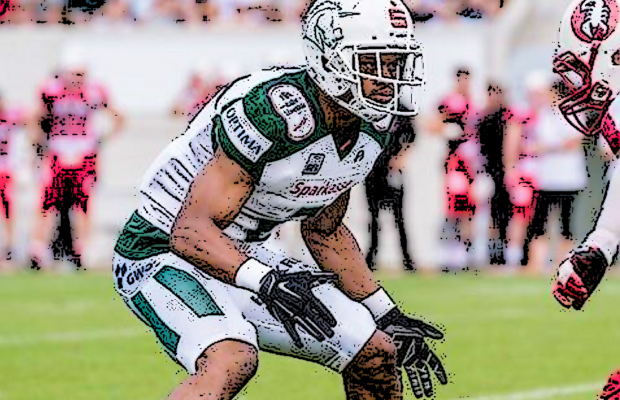Defense in Germany: Create pressure with the press

The German Football League, the GFL, has become a passing league. The stats prove it.
In 2008, the top 6 offenses in the league had a passing average of 2,503 yards. Compare that to 2018 where the top 6 offenses had a passing average of 4,113 yards. Although rushing yards have stayed relatively the same during the same time span, namely, 1,867 in 2008 versus 1820 in 2018, total touchdowns have increased for the top 6 teams, jumping from 41 in 2008 to 67 in 2018. Therefore, if you want to have an exceptional defense in the GFL, you are going to have to stop the pass.
In order to stymie your opponent´s passing game, dominant cornerback play becomes vital. Not only can lock-down cornerbacks alter an opponent´s game plan, but they can also change the course of the game.
Press alignment by a corner does not mean you have to play man-to-man coverage. Pressing your cornerbacks a majority of the time is an excellent way to disguise your coverages and limit the number of routes a receiver can run.
With proper technique, press alignment will disrupt the timing of an offense as well as eliminate big plays. Depending on the coverage, you will also be able to use your safeties aggressively in the run game and apply various man and zone blitz concepts to keep an offense off-balance. There are several tactics a corner can use when playing press coverage, but they can be broken down into two distinct categories: hard press or soft press.
Hard Press
Hard Press or Bump-and-Run coverage is best used when the cornerback has safety help over the top. When playing cover 1 or cover 2, it is best to have outside leverage, so that the cornerback can force an inside release by the receiver. If the receiver is on the line of scrimmage, the corner should be able to touch him with his fingertips. If the receiver is off the line of scrimmage, the corner should be two yards away from him.
Inside leverage is typical when in man to man coverage, however with outside leverage the cornerback has help on any post or dig route, especially when the defense has either a linebacker or safety defending the hole. If the receiver runs a slant route or any other inside breaking route, the cornerback should ride the receiver´s upfield shoulder and flatten him down the line of scrimmage.
Inside leverage is best used when in cover 0, since there will be no inside help or if the receiver aligns close to the sideline, because chances are he will run an inside breaking route. The aggressive, physical style of hard press wears receivers out over the course of the game and forces them to earn their receptions.
Soft Press
Soft Press or Shadow Press is best used when in cover 3 or cover 4.
When in cover 3, the corner should only press when there is no detatched #2 receiver. If there is a slot receiver, the corner should line up in off coverage on the #1 receiver, so that he can key any vertical release by the #2 receiver. As with hard press, aligning with outside leverage is best, unless the receiver is aligned close to the sideline, or aligns in a wide split. A wide split usually is an indication that the receiver will run an inside breaking route. Alignment on the receiver is no different than when playing hard press technique. If the receiver is on the line of scrimmage, the corner should be able to touch him with his fingertips; if the receiver is off the line of scrimmage, the corner should be two yards away from him.
The difference between soft press and hard press is that soft press focuses on staying over the top of the receiver rather than disrupting the route at the line of scrimmage. In soft press, it is crucial that the corner backpedals and reads the release of the receiver; he can then extend his near arm in front of the receiver’s chest and shadow the receiver.
Stance important
As with any position in football, it is essential that a cornerback has a good stance. A proper and comfortable stance ensures a positive impact on a cornerback’s initial steps. Whether playing hard or soft press technique, the stance stays the same.
- Feet should be directly under armpits, slightly tighter than shoulder width with weight placement on the balls of the feet. When playing a hard press technique, this hinders the player from getting over-extended and lunging at the receiver; when playing a soft press technique it allows an easy transition into a backpedal.
- Bend at the waist with the chest over the knees or the nose over the toes. Keep the hips low and place the stress on the hamstrings. Think „Z“ in the knees.
- Arms should be relaxed with the elbows in and thumbs in an upward position. They should be ready to explode on the movement of the receiver, whether it be to backpedal or jam the receiver at the line of scrimmage.
With the prevalence of passing in today’s GFL, it is necessary to have a strong passing defense if you are going to have a good defense.
Press coverage attacks the quarterback’s ability to quickly deliver the ball to open targets. By mixing up coverages, the use of press alignment complicates things for an offense and allows a defense to be aggressive instead of conceding unnecessary yards and, more importantly, touchdowns.